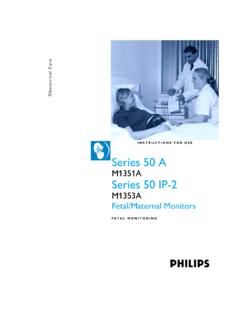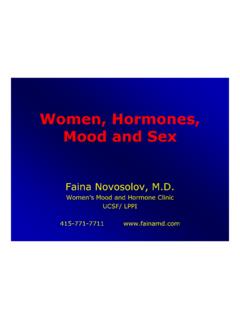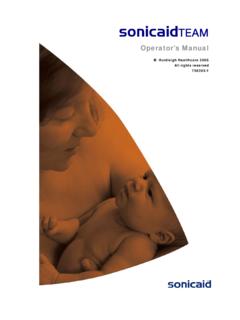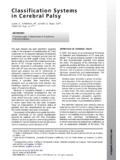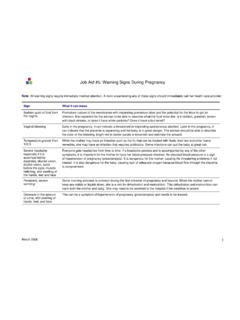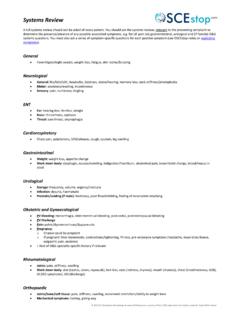Transcription of Anaesthesia for Caesarean Section. Part 1 Introduction and ...
1 Anaesthesia for Caesarean section . part 1 Introduction and Overview James Brown Royal Devon and Exeter Hospital United Kingdom A series of three tutorials exploring the management of Caesarean section . part 1: Introduction and Overview part 2: Caesarean section under Regional Anaesthesia part 3: Caesarean section under General Anaesthesia Extracts of these tutorials have contributed to: Brown JPR. Recent Developments in Anaesthesia for Caesarean section in the UK. Update in Anaesthesia . 2008; 23 Self Assessment Q1 When considering indications and categorisation of Caesarean sections: a) Caesarean section caries an overall higher neonatal mortality compared with normal delivery?
2 B) Recommended population Caesarean section rates are less than 5%? c) Breech presentations should routinely be booked for a Category 4 Caesarean section ? d) A category 1 Caesarean section should aim to be delivered within 45 mins to prevent detrimental fetal outcome? e) Category 1 Caesarean sections should be delivered under general anaesthetic where immediately available? Q2 In relation to Oxytocic drugs: a) Syntocinon is a synthetic analogue of the naturally occurring oxytocin which is released from the anterior pituitary gland? b) 10 units of syntocinon should be given as an bolus on delivery of the baby at Caesarean section ?
3 C) If given for a prolonged period of time syntocinon can result in convulsions? d) The half life of syntocinon is 10 mins? e) Ergometrine is commonly combined with syntocinon as an intravenous preparation as a second line treatment of uterine atony? Q3 You are called urgently to the labour room to assess a woman with fetal distress. Your immediate actions may include: a) Assessing the severity of fetal distress? b) Establishing intravenous access? c) Ensure the mother is always placed in the left lateral position (using a wedge)? d) Methods to reduce uterine contraction strength and frequency?
4 E) Assessment and preparation of the patient for consideration of appropriate anaesthetic technique? Q4 Recommendations from the latest Confidential Enquiry into Maternal and Child Health (CEMACH) to prevent maternal and neonatal mortality and morbidity include: a) Pre-conception counselling? b) Routine medical assessment prior to 20 weeks? c) Women who have had previous Caesarean section should be booked for a category 4 section ? d) The report suggests medical, midwife and obstetric staff are good at early recognition of critical illness in obstetric patients? e) The report found overall maternal mortality of 1:1000 in the UK?
5 Key Points Caesarean section is undertaken to improve maternal or fetal outcome. There is an increasing rate of Caesarean section . Currently 1 in 5 pregnant women are delivered by Caesarean in the UK. Many factors influence the method of Anaesthesia used. There is an informed trend towards regional Anaesthesia in the majority of cases. Good communication between the multidisciplinary team is essential, especially in the emergency situation where urgency is best communicated by a universally understood categorisation system. Introduction Caesarean section is undertaken to improve maternal or fetal outcome, or to reduce anticipated complications from spontaneous labour and vaginal delivery.
6 Over the last ten years the rising Caesarean section rate in the developed world has stimulated discussion of best anaesthetic and obstetric practice. Much of the impetus for improving obstetric care in the UK has been driven by the findings of the Confidential Enquiry into Maternal and Child Health (CEMACH), formerly the Confidential Enquiry into Maternal Death (CEMD). Over a three year period, CEMACH reports the deaths of UK women while pregnant or within 42 days of the end of pregnancy. An extensive audit of the management of Caesarean sections in the UK was reported in findings contributed to the development of guidelines by the National Institute for Health and Clinical Excellence (NICE), a UK agency responsible for advising on best clinical practice.
7 NICE published guidance on Caesarean section in 2004 and made recommendations that form a standard of care on obstetric and anaesthetic aspects of management. WHO recommends an optimum Caesarean section rate of 5-15% to ensure best outcome for mother and neonate. Rates in Sub-Saharan Africa are a lot lower than this, possibly as low as 1%. This is a reflection of availability of resources and distance from medical facilities and trained staff. This low rate contributes to a high maternal and neonatal morbidity and mortality. Maternal mortality has been estimated to be over 1% in West Africa and severe maternal morbidity as high as 9%.
8 These mortality and morbidity rates are over 30 times those of the developed world. It has been suggested that as a minimum, a health service should aim to provide Caesarean section for maternal indications, if not neonatal. The main maternal indications being obstructed labour, placental abruption, previous Caesarean section , eclampsia, placenta praevia and malpresentation. In areas where HIV is prevalent, Caesarean section may be increasingly indicated to reduce risk of transmission from mother to child. Caesarean section itself is associated with a significant morbidity and mortality and improvements in surgical and anaesthetic management can reduce this.
9 In a prospective study conducted in Latin America which investigated more than 105,000 deliveries, mothers delivered by Caesarean section were over 2 times more likely to suffer from severe maternal morbidity compared with vaginal delivery. Neonatal mortality was also increased by over times. Caesarean section was found to be protective in breech presentation. Indications for Caesarean section Previous Caesarean section * Malpositions* (Breech) Fetal Distress* Dystocia (Failure to progress during labour) * Maternal Disease o Worsening pre-existing disease ( cardiac) o Associated with pregnancy ( pre-eclampsia) Placenta Praevia or abruption Multiple Pregnancy Cord Prolapse Maternal Choice * indicates 4 commonest reasons (constituting over 70% of Caesarean Sections)
10 Categories of Caesarean section The traditional categorisation of Caesarean section into elective or emergency has limitations for both optimal communication in the clinical setting and for post-delivery audit. A four tier classification has been proposed and broadly accepted. Grade Definition Category 1 Immediate threat to life of woman or fetus ( Placental Abruption, Uterine Rupture, Active Bleeding, Severe Fetal Compromise) Category 2 Maternal or fetal compromise, not immediately life threatening Category 3 Needing early delivery but no maternal or fetal compromise Category 4 At a time to suit the woman and maternity team The suggested standard for a category 1 Caesarean section is delivery within 30 minutes of the time of decision.










